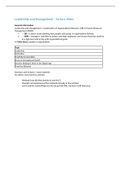Leadership and Management – lecture slides
General information
Leadership and Management = combination of Organizational Behavior (OB) & Human Resource
Management (HRM).
– OB = is about understanding how people and groups in organizations behave.
– HRM = managers’ activities to attract and keep employees and ensure that they perform
at a high level and in line with organizational goals.
=> Main focus: people in organizations.
Topic
Leadership
Motivation
Creativity & Innovation
Stress & Occupational Health
Decision Making & Work in the Digital Age
Proactive Behavior
Seminars and lectures = exam material
10 articles (not overview articles)
- Method (how did they decide to test this?)
- Strength and weakness of the methods (already in the articles)
- Learn authors (somethings you do not get the title, because it will help you)
,1. Lecture 1 - Leadership
Leadership Definitions:
“A process of social influence whereby a leader steers members of a group
towards a goal” (Bryman, 1992).
“A process of social influence in which one person is able to enlist the aid
and support of others in the accomplishment of a task” (Chemers, 2000).
Leaders are made, not born
1.1 Trends in leadership theory and research
Ethical & servant wordt
niet besproken in de
course
1.1.1. Trait theories of leadership (up to late 40s) Who is the
leader?
Trait theories suggest that leaders are born (i.e., selection is important).
They consider how personality, social, physical and/or intellectual traits may
differentiate leaders from non-leaders.
Personality has not been found to be very predictive, but in terms of the big five
personality framework:
Extraversion is found to be the most important factor of the big 5 –
although it’s more predictive of leader emergence than leader
effectiveness – i.e., sociable/assertive people are more likely to assert
themselves in group situations.
Conscientiousness and openness to experience also show strong and
consistent relationships to leadership.
How are physical traits associated with leadership?
For example: Height is related to leadership (does not mean it is a good leader,
he is more likely to be a leader)
Taller people are more likely to be leaders.
And to earn higher salaries.
Also: Overweight executives tend to get lower leadership ratings.
*Possible evolutionary explanation
Note only that:
While traits can predict leadership, they are better at predicting leader
emergence than effectiveness ‘ze voorspelen of ze een leider worden,
niet de effectiviteit ‘
, Also, while traits help us to predict leadership, they don’t help us to
explain leadership. There is always an indirect effect between a trait and
the outcome of leadership.
The next set of theories suggest that leaders are made (i.e., training is
important).
1.1.2. Styles and behaviours (late 40s – 60s) What does a leader
do?
Behaviour is directly observable.
Behaviour can more easily be changed.
Direct relationship with leadership effectiveness.
Being able to distinguish (in)effective leadership behaviour will help us to
design leadership talent management systems: hire, develop, and
promote the skills necessary for leadership success.
=> Key assumption: there are universally effective leadership behaviours.
How did they study leadership behaviour?
Approach to research:
Identify differences in behaviour between effective versus ineffective leaders.
Methods:
− Observe leaders
− Interview/survey leaders about how they lead.
− Interview/survey followers about their leaders’ behaviour.
− Diary studies with leaders (longitudinal perspective).
− Newer techniques: trackers (e.g., stress-level), apps.
STUDY 1 - Ohio State university research
Initiating structure: How much a leader emphasizes meeting work goals
and accomplishing tasks.
Leaders high in initiating structure engage in many different task-
related behaviors e.g., assigning deadlines, establishing performance
standards and monitoring performance levels.
Consideration: How friendly and supportive a leader is towards followers.
Leaders high in consideration engage in many different behaviors that
show supportiveness and concern, such as speaking up for
subordinates’ interests, caring about their personal situations and
showing appreciation for their work.
STUDY 2 – University of Michigan Research
tried to identify leader behaviors that contributed to effective group
performance.
They identified four categories of leadership behaviors, namely:
1) Goal emphasis
, 2) Work facilitation
3) Leader support
4) Interaction facilitation.
– Goal emphasis and work facilitation were job-centered dimensions,
thus similar to the OSU dimension of initiating structure.
– Leader support and interaction facilitation were employee-centered
dimensions, thus similar to the OSU dimension of consideration.
CONCLUSION (both studies)
UoM researchers (study 2) considered job-centered and employee- centered
leadership to be at opposite ends of a single continuum of leadership behavior.
▪ Thus, UoM researchers considered which type of leadership behavior was more
effective in helping teams to achieve their goals, job or employee-centered
leadership.
Ohio state (study 1) researchers believed that consideration and initiating
structure dimensions were independent continuums.
▪ Thus, they asked whether leaders that scored high on both dimensions were
more effective than those that scored high on only one.
So..
▪ The most effective leadership style also appears to depend on the criteria used
to judge effectiveness.
– Consideration is especially important for follower satisfaction, motivation and
leader effectiveness.
– Initiating structure is esp. important for group/organizational performance.
▪ In addition, it may be expected that the effectiveness of leader styles may vary
depending on the context i.e., the type of organization, national culture etc.
▪ This suggests that a contingency approach may be needed...





